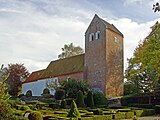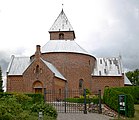Country churches (Djursland)

The number of rural churches on Djursland is large compared to the area of the peninsula and Denmark . A comparable constellation can be found on Gotland in Scandinavia . When most of today's 75 churches were built, Jutland 's largest lake, Kolindsund , which is now silted up , still divided the Djursland peninsula almost in the middle.
In pre-Christian times, cult sites were often on hills. The Christianity adopted many of these places. There are therefore few churches built in the valleys on Djursland. The building material for the churches comes from the area. Limestone was extracted from the steep slopes near Grenaa . Like almost a thousand churches throughout Jutland, naves and choirs were built from granite blocks in Djursland , painstakingly carved out of large boulders . Smaller field stones from the Ice Age were also popular. Trachyte was easier to work with . When the art of brick-making was introduced from Italy in the mid-12th century, people became independent of these natural building materials .
The Romanesque church building in the country consisted of the nave , the choir and in some cases an apse . As in most parts of Jutland, from the 13th, but especially in the 14th century, the churches were expanded to include the entrance hall typical of Denmark (with the martial name våbenhus - " armory ") and a church tower . This development also occurred in areas in which no nobility worth mentioning was formed. A regional feature Djurslands is the stilts tower ( styltetårn ). About a third of the churches and towers had stepped gables .
Many of the baptismal fonts and church portals on Djursland date from the 13th century. Those from the workshop of the stonemason Horder , whose date of life is only 1175, have characteristic ornaments made of cordage and acanthus tendrils . His name was found on a tombstone from Løvenholm Castle . He is attributed (after Weilbach's Kunstnerleksikon) another twelve works in Jutland , two in fishing (for example in the Grundhofer church ) and two on Funen .
After the Reformation , the churches became estates. Interest now turned to the inventory, especially the altar and the pulpit , while the frescoes lost their importance. Its original function was to familiarize the largely illiterate community with biblical stories. Their disappearance is also related to the fact that oil painting appeared, which preferred a different surface. There are only a few churches on Djursland that still have frescoes after the Reformation.
- Country churches in Djursland
Gjesing, Norddjursland :
Jütischer Standard - Romanesque granite ashlar with additions from white brick geschlämmtemVoldby, North Djursland - started in the 13th century, everything is brick, everything is white
Koed Kirke, Süddjursland - Romanesque field stone walls whitewashed , Gothic brick walls natural color
Individual case: Thorsager round church
See also
literature
- Inger Hørup: Kirkerne på Djursland . Ed .: Århus Amt, Erhvervsafdelingen. 1993, ISBN 87-984055-1-9 .
- HK Hein: Horder: en romansk stenmester . Ǻrhus 1966.




